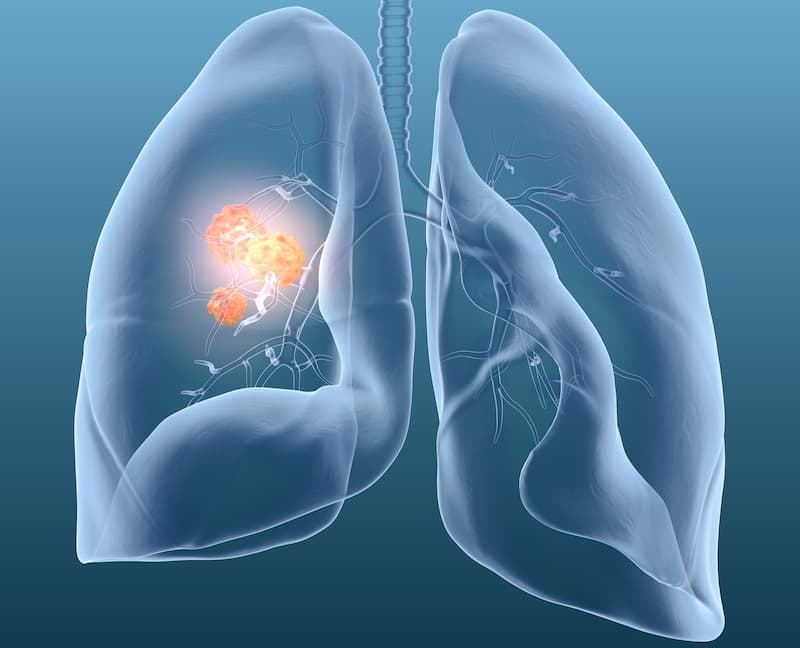Nadunolimab Combo Exhibits Early Efficacy in Advanced NSCLC
Particularly strong efficacy signals were observed in patients with non-squamous non–small cell lung cancer previously treated with PD-1 inhibition.
Among patients with nonsquamous NSCLC previously treated with pembrolizumab, the median PFS and OS were 10.4 months and 26.7 months, respectively.

Nadunolimab (CAN04), when used with platinum-based chemotherapy, exhibited promising early efficacy outcomes in a small cohort of patients with advanced non–small cell lung cancer (NSCLC), according to results from the phase 2a CANFOUR trial (NCT03267316) published in Lung Cancer.1
After a median follow-up of 12.4 months (95% CI, 10.7-15.2), efficacy data from the trial revealed that among 40 patients with advanced NSCLC treated with at least 1 dose of nadunolimab, the median progression-free survival (PFS) was 7.2 months (95% CI, 5.6-9.2). The 6- and 12-month PFS rates were 58% (95% CI, 41%-72%) and 19% (95% CI, 8%-33%). Additionally, the median overall survival (OS) was 13.7 months (95% CI, 11.1-18.3), with respective 12-, 24-, and 36-month OS rates of 54% (95% CI, 37%-69%), 26% (95% CI, 13%-42%), and 14% (95% CI, 5%-30%).
Regarding response, the objective response rate (ORR) was 55% (95% CI, 38%-71%) among this patient population, including 5% of patients achieving a complete response (CR) and 50% attaining a partial response (PR). A total of 33% of patients experienced stable disease as best response, for a disease control rate (DCR) of 88% (95% CI, 73%-96%). The median duration of response (DOR) was 6.4 months (95% CI, 4.4-9.9).
“These positive data published in Lung Cancer describe an important potential opportunity for nadunolimab, with possibilities to address a major unmet medical need,” Damian Marron, interim chief executive officer of Cantargia, said in a news release on the publication of the study.2 “We are particularly encouraged by the strong signal in patients with non-squamous NSCLC post PD-1 inhibitor treatment”.
Among patients with nonsquamous NSCLC previously treated with pembrolizumab (Keytruda; n = 11), the median PFS and OS were 10.4 months (95% CI, 5.3-22.2) and 26.7 months (95% CI, 6.2-NE [not evaluable]), respectively. Additionally, after a median follow-up of 16.5 months (95% CI, 6.6-29.2), the ORR and DCR were 91% (95% CI, 59%-100%), with 2 CRs observed in this cohort. The median DOR was 9.1 months (95% CI, 3.7-NE).
Patients 18 years and older with histologically or cytologically confirmed, unresectable stage III or IV NSCLC, eligible to receive platinum-based chemotherapy (n = 43), were enrolled on the trial. Patients received nadunolimab with either cisplatin/gemcitabine (NCG) as frontline chemotherapy (n = 33) or carboplatin/pemetrexed (NCP) as either first-line chemotherapy or as second-line therapy following progression on pembrolizumab monotherapy (n = 10).
Patients in the NCG group received either 1.0, 2.5, or 5.0 mg/kg of nadunolimab once weekly for 5 infusions, followed by biweekly administration thereafter. Cisplatin was given at 75 to 100 mg/m2 on day 1 and gemcitabine at 1250 mg/m2 on days 1 and 8 of 21-day cycles for 4 to 6 cycles in the absence of progression or unacceptable toxicity. Patients could continue nadunolimab monotherapy or with gemcitabine.
The NCP group received 2.5 mg/kg of nadunolimab combined with carboplatin at area under the curve of 5 mg/mL/min and pemetrexed at 500 mg/m2 on day 1, and nadunolimab alone on day 8 of 21-day cycles for 4 to 6 cycles. Patients received nadunolimab monotherapy or with pemetrexed in the absence of progression or unacceptable toxicity, and G-CSF was recommended as prophylaxis during the study.
The intention-to-treat population was composed of 75% of patients treated with NCG and 25% of patients treated with NCP. The median age was 64.5 years (range, 39-77), and 63% of patients were male. Most patients had an ECOG performance score of 1 at baseline (60%), stage IV lung cancer at diagnosis (90%), non-squamous histology (65%), and had tumor localization to the lymph nodes upon study entry (88%).
The most common prior therapies included pembrolizumab monotherapy (43%), radiation therapy (15%), and surgery (10%). Biopsies were received in 85% of patients at baseline and 43% while on treatment.
The study assessed efficacy overall, by line of therapy, and by histology type, and measures included OS and PFS outcomes, as well as response outcomes. Safety was also assessed, with the population including all patients who received at least 1 dose of nadunolimab. An exploratory analysis of nadunolimab’s impact on grade 3 to 4 adverse effects (AEs) and efficacy end points was performed through regression models.
Any-grade AEs were observed in 95% of patients treated with at least 1 dose of nadunolimab, with 93% of patients experiencing grade 3/4 AEs. Grade 3/4 AEs considered related to nadunolimab were observed in 77% of patients. SAEs were observed in 56% of those treated.
Dose-limiting toxicities (DLTs) were observed in 9% of patients, with AEs leading to study discontinuation in 5%. Grade 5 AEs occurred in 5% of patients.
References
- Paulus A, Zemaitis M, Cicenas S, et al. Safety, efficacy, and analysis of biomarkers in patients with advanced non-small cell lung cancer treated with the anti-IL1RAP antibody nadunolimab (CAN04) in combination with platinum doublet. Lung Cancer. Published online July 14, 2025. doi:10.1016/j.lungcan.2025.108664
- Cantargia announces publication of clinical data showing benefit of nadunolimab combination therapy in advanced lung cancer. News release. Cantargia. July 16, 2025. Accessed July 17, 2025. https://tinyurl.com/2revsn24
Newsletter
Stay up to date on recent advances in the multidisciplinary approach to cancer.